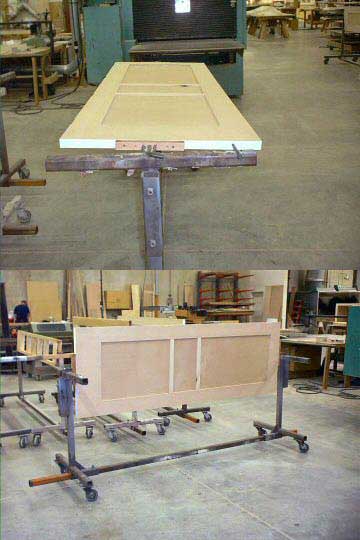Wipe-On Finish for Cabinet Interiors
Here's a tip: try using a wipe-on water-based finish just for cabinet interiors, to avoid all the hassles that come with spraying inside a box. December 8, 2006
Question
I am spraying credenzas in a high gloss finish and I was wondering if anyone out there sprays the whole thing inside and out high gloss? Or does anyone spray the inside a matt/satin. Im not really sure of the norm.
Forum Responses
(Finishing Forum)
From contributor T:
Unless the customer specifies (which I recommend you ask them just so you don't get a nasty surprise) I would just go with the flow and use gloss unless you want a duller sheen to try to hide something.
I would also, if possible, spray the cabinets with the backs not in place. I always spray my cabinets with the backs removed (they just slip out of the dado). This eliminates problems with overspray in the boxes and also saves me from burning the fool out of my eyes trying to look into a big old base cabinet full of fog so I can see where I'm spraying.
From contributor M:
When spraying inside cabinets, try adding about 5-10 % retarder, this will give you better flow out.
From contributor A:
I always finish cabinet interiors with either satin (sometimes) or semigloss (usually). Either of these is more forgiving that a high gloss finish. When not using pre-finished ply, I've recently found a solution that seems to work well. If possible, I finish the interior before assembly. I've also begun to use a W/B poly that I can wipe on with a foam or fiber applicator (commonly used in floor finishing). I've been using Parks W/B poly from Home Depot. The stuff is water thin (intended for horizontal application), so I lay whatever side I'm applying finish to down flat. Advantages: no spraying the insides; fast; no persistent fumes hanging around inside the cab to annoy the client.
From contributor T:
To contributor A: How fast does the stuff you mention cure to a sandable finish?
From contributor A:
Depending on the humidity and the wet film thickness, it's sandable in 30 minutes to one hour. Since its WB, it will raise the grain a little. I typically use one coat of sanding sealer, wait 45 minutes, sand lightly and apply 1-2 coats of topcoat without sanding. This usually yields a very serviceable finish, esp. for cabinet interiors. I also use this solution to refinish the insides of drawers. If you try this, be sure to wash out the new foam pad before use. The new foam pads usually shed a little, and washing them removes most of the loose hairs.
